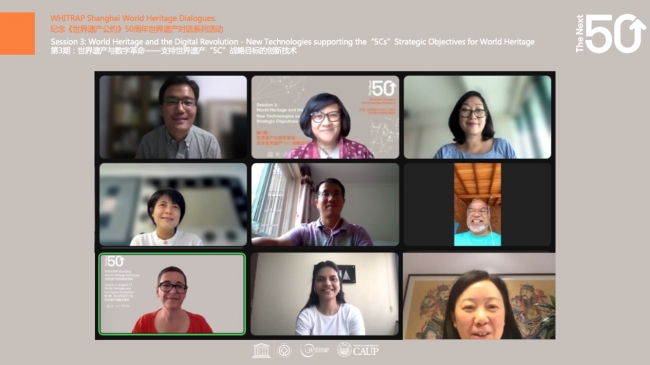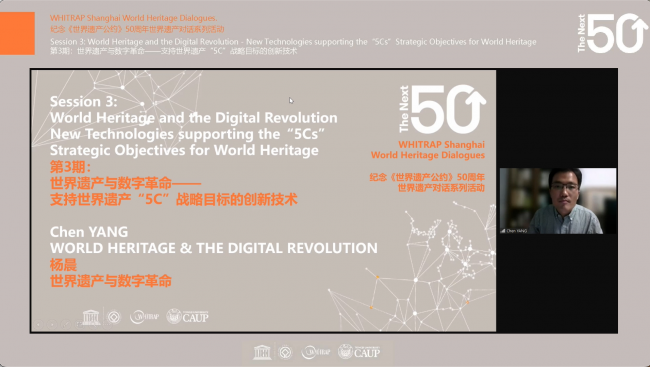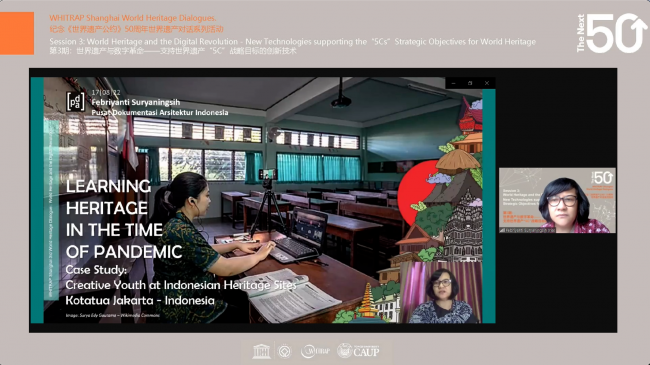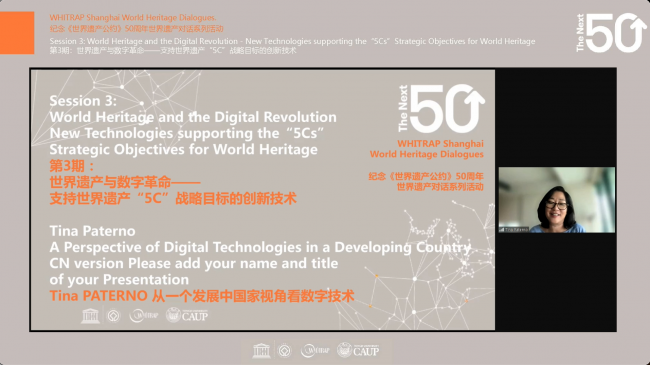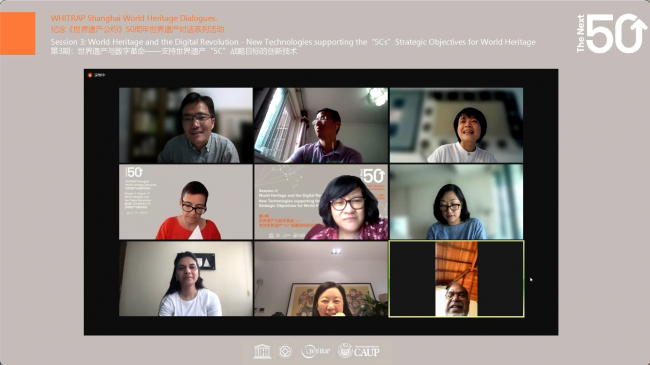| Summary | 3rd WHITRAP World Heritage Dialogue |
| Author:MN. Tournoux PublishDate:2022-08-29 Hits:1707 |
The 3rd WHITRAP Shanghai World Heritage Dialogues, was held on 17 August 2022. It focused on "World Heritage and the Digital Revolution. New technologies supporting the '5Cs' Strategic Objectives for World Heritage". For the video of the activity, please visit: http://heritap.whitr-ap.org/index.php?classid=12497&id=37&t=show 01 Background
The 6 monthly online thematic Dialogues series are organized by WHITRAP Shanghai and hosted by the College of Architecture and Urban Planning (CAUP), Tongji University and their outcomes and the Digital Revolution theme will be presented and further discussed and presented on 15-16 November in an international conference on "World Heritage and Urban-Rural Sustainable Development: Resilience and Innovation" also organized by WHITRAP and CAUP Tongji University. The 3rd Dialogue was devised and chaired by Marie-Noël TOURNOUX, Project Director WHITRAP Shanghai and co-organized and moderated by Prof. YANG Chen, CAUP, Tongji University. Five experts from the Asia and Pacific Region where invited to share their views on the topic of World Heritage and the Digital Revolution. • Prof. CHEN Fulong Deputy director HIST UNESCO Category 2 Centre, Beijing, China • Febriyanti SURAYANINGISH, Director of the Pusat Dokumentasi Arsitektur, Jakarta, Indonesia • Associate Prof. HAN Jie, School of Architecture and Civil Engineering, Xiamen University, Xiamen China • Mayura GADKARI, Urban Development Practitioner, National Institute of Urban Affairs, New Delhi, India • Tina PATERNO, President ICOMOS Philippines, Philippines
Group photo 02 Opening
After welcoming the participants and audience, the Chair, recalled the objective of the Dialogues, imagining the Next 50: World Heritage as a source of resilience, humanity and innovation and reiterated the 3rd Dialogue aimed to invite the participants and audience to consider digital tools and the digital revolution in relation to the Convention’s statutory tools developed to help the World community to reach the objectives of the Convention. More specifically, it would consider the Strategic Objectives for World Heritage, also known as the 5Cs (Credibility, Conservation, Capacity Building, Communication, Communities) adopted in 2002, twenty years ago, and 2007 by the World Heritage Committee. 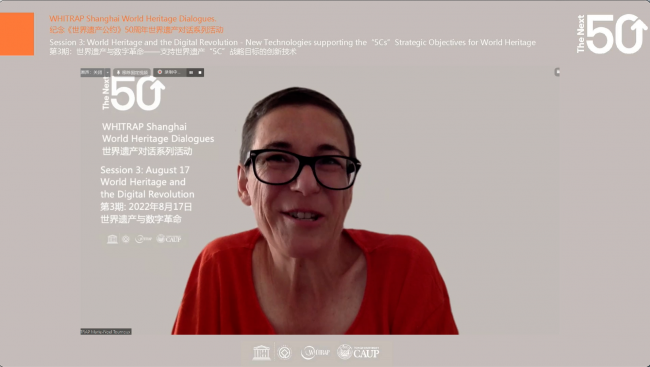 Marie-Noël TOURNOUX
Project Director at WHITRAP Shanghai
03 Introduction
Prof. YANG Chen, introduced the 3rd Dialogue’s theme "World Heritage and the Digital Revolution. New technologies supporting the '5Cs' Strategic Objectives for World Heritage". He presented the current developments and challenges in the digital conservation of World Heritage how the digital revolution is changing the way we view World Heritage, our understanding of World Heritage, the way the global World Heritage community works together. He then introduced their transformational impacts: •enhancing the quality of recording and producing documentation; •monitoring and managing World Heritage on a larger and more complex scale; •converting the interpretation from object-orientated to visitor-orientated; •digitalizing has changed the mechanisms of World Heritage knowledge production. Finally, he emphasized that digital technology is only a technology, a tool, and that the key point is how to properly and effectively use technology to serve the goal of heritage protection.
YANG Chen
Professor at College of Architecture and Urban Planning (CAUP), Tongji University
04 Pecha Kucha session
In his presentation, “Land cover change and the sustainable conservation of world cultural heritage”, Prof. CHEN Fulong discussed how digital technology such as Earth Observation and emerging technologies support the “5Cs” Strategic Objectives for World Heritage. 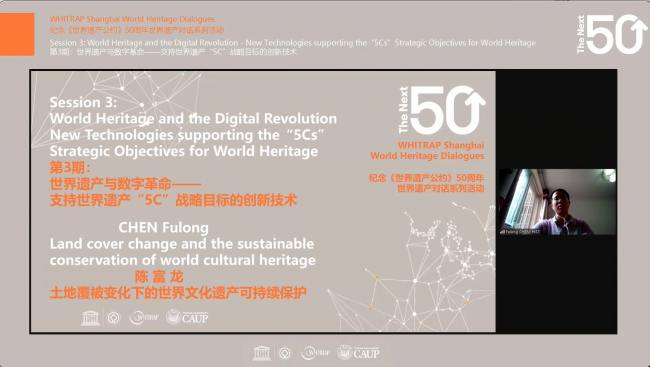 Prof. CHEN Fulong
Deputy director HIST UNESCO Category 2 Centre, Beijing, China
In her presentation “Learning Heritage in The Time of Pandemic”, Febriyanti SURAYANINGISH, focused on a creative learning program for youth “Creative Youth at Indonesian Heritage Sites" aiming to empower and benefit young entrepreneurs in various heritage sites in Indonesia. Due to the COVID 19 Pandemic, the capacity training program had to be re designed to adapt to the lockdown constraints.
Febriyanti SURAYANINGISH Director of the Pusat Dokumentasi Arsitektur, Jakarta, Indonesia
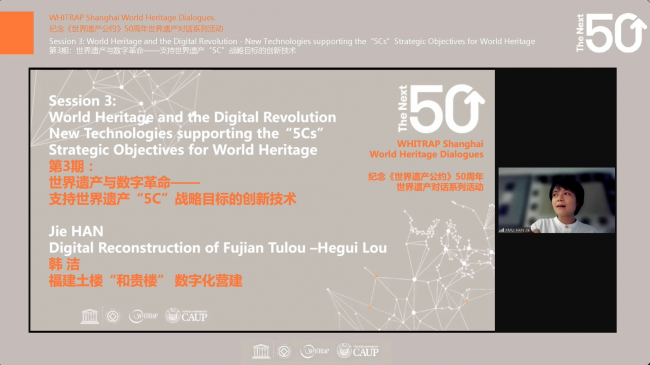 Associate Prof. HAN Jie
School of Architecture and Civil Engineering, Xiamen University, Xiamen China
In her presentation "Cultural Heritage: The Digital Future", Mayura GADKARI looked at urban living heritage, focusing mostly on the civic engagement and knowledge and planning tools as well as capacity building benefiting better planning processes, ensuring continuous training of decision-making entities and enhancing community engagement. 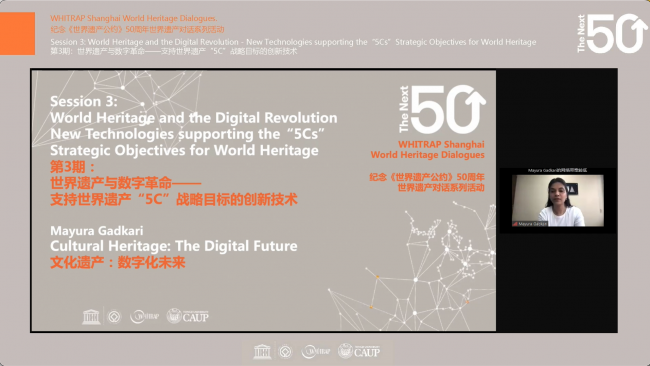 Mayura GADKARI
Urban Development Practitioner, National Institute of Urban Affairs, New Delhi, India
In her presentation, “A Perspective of Digital Technologies in a Developing Country”, Tina PATERNO, focused on the advantages and challenges of new technology in the heritage preservation field in particular the need to raise awareness to the benefits and limits of new technologies.
Tina PATERNO
President ICOMOS Philippines, Philippines
The Moderator Prof. YANG Chen invited guests to reflect on two questions: • What are the most important qualities of digital technologies for World Heritage? • What new perspectives has the digital revolution brought to World Heritage? The round table was followed by questions from the audience and contributions by Gamini WIJESURIYA, WHITRAP Special Advisor and Prof. SHAO Yong, College of Architecture and Urban Planning (CAUP), Tongji University. Question from members of the audience: "How to understand the authenticity of world cultural heritage in the context of digital heritage?"
Round table discussion 06 Wrap up
Marie-Noël TOURNOUX summarized the key points. The Dialogue showcased the strength and relevance of the Convention, and the ways the Digital Revolution can achieve to support reaching the 5Cs, the World Heritage Objectives. The discussion focused not only on new technological frameworks, but also on the development of new methodologies and approaches, as well as detailing the transformational impacts of digital technology on World Heritage and stakeholders, in particular regarding, governance, knowledge development, social transformation, heritage values. In conclusion the Moderator and the Chair thanked the participants and the audience. The next Dialogue is on 14 September: “World Heritage and Climate Change”.
For the video of the activity, please click the link below: http://heritap.whitr-ap.org/index.php?classid=12497&id=37&t=show Authored by MN. Tournoux Typeset by JI Zhenjiang (Intern) |
- News | WHITRAP Shanghai and CNR-ISPC bilateral meeting
- News | WHITRAP meets Cité de l’Architecture et du Patrimoine
- WHITRAP Hosting "Workshop on Preliminary Assessment for National Focal Points of the Asia Region" in Chengdu
- WHITRAP Shanghai meets UNESCO
- INTERNATIONAL CONFERENCE PRELIMINARY ANNOUNCEMENT & CALL FOR PAPERS
- Observation of the 46th Session of the World Heritage Committee
Copyright © 2009-2012 World Heritage Institute of Training and Research-Asia and Pacific (shanghai)


